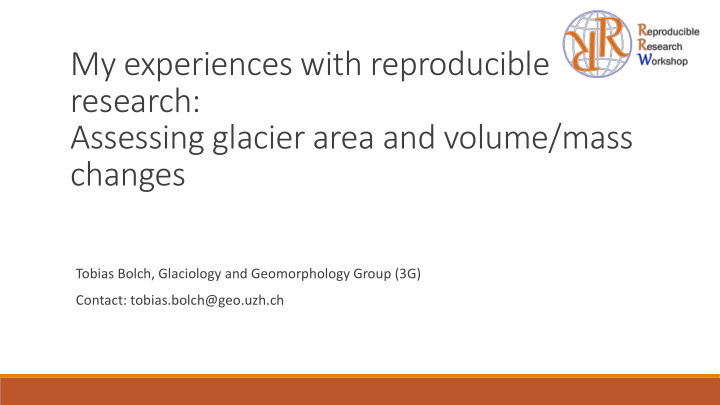



My experiences with reproducible research: Assessing glacier area and volume/mass changes Tobias Bolch, Glaciology and Geomorphology Group (3G) Contact: tobias.bolch@geo.uzh.ch
• How would you define reproducibility? Bolch 2003 2 INNOPOOL WORKSHOP REPRODUCIBLE RESEARCH: SESSION 1
Have you ever tried, failed, or succeeded to reproduce another researcher’s results? Example: Glacier area / outlines: Glacier area of High Asia: • Dyurgerov and Meier (2005): 116,180 km² • Randolph Glacier Inventory (Pfeffer et al. 2014): 119,878 ± 9201 km² • GAMDAM (Nuimura et al. 2015): 91,263 ± 13 689 km² What are the reasons for the differences? Glacier changes? Different data sources? Different methods? Different definition? 3 INNOPOOL WORKSHOP REPRODUCIBLE RESEARCH: SESSION 1
Have you ever tried, failed, or succeeded to reproduce another researcher’s results? Example: Glacier area of High Asia: Dyurgerov and Meier 2005: 116,180 km² Dolgushin & Osipova, 1989 4 INNOPOOL WORKSHOP REPRODUCIBLE RESEARCH: SESSION 1
Inventories for the Himalaya Nuimura et al. 2015 5 INNOPOOL WORKSHOP REPRODUCIBLE RESEARCH: SESSION 1
Paul et al. 2013 6 INNOPOOL WORKSHOP REPRODUCIBLE RESEARCH: SESSION 1
Changes of Gangotri Glacier / Garwhal Himalaya Annual retreat rate of Gangotri Glacier by various authors 7 INNOPOOL WORKSHOP REPRODUCIBLE RESEARCH: SESSION 1
Glacier Mass Changes at Mt. Everest Mass change (m w.e. a -1 ): 1970 – 2007: -0.32 ± 0.08 2002 – 2007: -0.79 ± 0.52 Gardelle et al. 2013: 1999 – 2011: -0.41 ± 0.21 Nuimura et al. 2012 2000 – 2008: -0.45 ± 0.60 Bolch et al. 2011, TC 8 INNOPOOL WORKSHOP REPRODUCIBLE RESEARCH: SESSION 1
• What kind of measures do you / the community take to improve the reproducibility of your research? • And which possibilities do you see to improve the reproducibility of your research / the research of the community? Clear documentation of methods (incl. uncertainty assessment) and utilized data Making codes and results (e.g. glacier outlines, dh/dt data) freely available Standardized and individually adjusted metadata Making data and codes available as prerequisite for a publication • What or which tools assist you in making your research reproducible? Commonly agreed recommendations/guidelines Databases to store the data (best with support) Major problem: Time and pressure to publish… 9 INNOPOOL WORKSHOP REPRODUCIBLE RESEARCH: SESSION 1
Are researchers in your field making an effort to make their research reproducible? • In general little willingness to share data freely and to make the research reproducible. • In many cases it is hardly possible to reproduce the results. • However, good exceptions exist and I feel an increasing willingness for data sharing and reproducibility. • Many researchers are now willing to submit their data to international databases, e.g. GLIMS initiative (with a standardized database for glacier outlines) WGMS (here at GIUZ, talk will follow) • One of the major journals in our field requires now a statement about how to access the data utilized in the study. 10 INNOPOOL WORKSHOP REPRODUCIBLE RESEARCH: SESSION 1
A tentative list of minimum requirements for a submission from a Regional Center is as follows: • glacier outline • GLIMS ID (based on the lat/lon location of a "centerpoint" on the glacier) • Data source • Date and time of analysis • Analyst's name • Analyst's institution • Description of processing, including algorithms The GLIMS initiative started in 1999, however a globally complete glacier inventory was only available in 2012 (RGI), The GLIMS database is still not globally complete… Why? • Technical issues but also lack of credit (The own paper is not cited , „just“ GLIMS). 11 INNOPOOL WORKSHOP REPRODUCIBLE RESEARCH: SESSION 1
Where in the research workflow do you see potential issues: • data collection (gathering, field/lab work), • preprocessing, analysis, (documentation), • paper writing (documenting/log/reasoning, figure/table/text reproduction)? 12 INNOPOOL WORKSHOP REPRODUCIBLE RESEARCH: SESSION 1
Which experiences with failures/successes in making research reproducible could be helpful for other people at the institute? • Use automated /standardized methods to produce data. • Describe methods short but precise (use supplement if required). • Good figures help a lot to understand and be able to interpret (and partly also reproduce methods/results. • When using/citing data /numbers try to find the original sources. • Establish an international standardized database and motivate colleagues to submit their data. • Make the submission as easy as possible and keep the requirements for data submissions low. • Ensure that the work done receives credits. • Talk to / contact colleagues (was quite successful for RGI). • Act as an editor / reviewer. 13 INNOPOOL WORKSHOP REPRODUCIBLE RESEARCH: SESSION 1
Recommend
More recommend